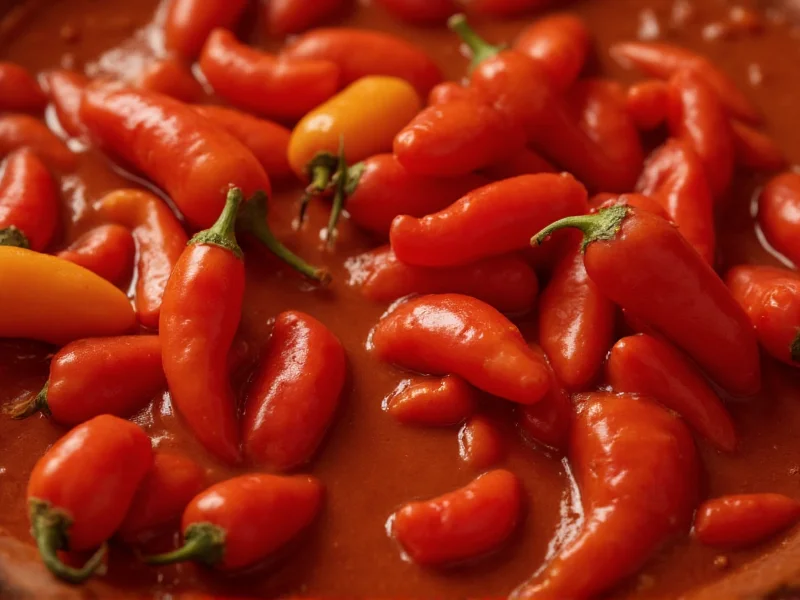When exploring chili level measurement, it's essential to understand that heat perception varies between individuals. The Scoville Organoleptic Test, developed in 1912 by Wilbur Scoville, originally measured heat through human tasters diluting pepper extract until the heat became undetectable. Today, High-Performance Liquid Chromatography (HPLC) provides precise capsaicinoid measurements, converting results to Scoville Heat Units (SHU) for consistency.
Understanding the Scoville Heat Scale
The Scoville scale remains the standard for measuring chili pepper heat levels, though modern science has refined its application. While the original test relied on subjective human tasting panels, contemporary methods use HPLC to objectively measure capsaicin concentration. This scientific approach eliminates variability from human testers' differing heat tolerances.
Several factors influence a chili's actual heat level beyond its genetic potential:
- Growing conditions - Soil composition, climate, and water stress affect capsaicin production
- Ripeness - Most chilies increase in heat as they mature and change color
- Plant position - Peppers growing in full sun often develop more heat than shaded counterparts
- Individual variation - Even within the same plant, heat levels can differ between fruits
Chili Heat Level Reference Guide
Understanding common chili varieties and their heat levels helps prevent culinary disasters and enhances recipe development. The following reference table organizes peppers by heat intensity:
| Chili Variety | Scoville Heat Units (SHU) | Heat Level Category | Common Culinary Uses |
|---|---|---|---|
| Sweet Bell Pepper | 0 SHU | Mild | Salads, stuffed peppers, raw consumption |
| Pepperoncini | 100-500 SHU | Mild | Greek salads, sandwiches, pickled applications |
| Jalapeño | 2,500-8,000 SHU | Medium | Salsas, nachos, poppers, pickled jalapeños |
| Habanero | 100,000-350,000 SHU | Very Hot | Hot sauces, Caribbean cuisine, spicy marinades |
| Ghost Pepper (Bhut Jolokia) | 800,000-1,041,427 SHU | Extremely Hot | Competitive eating, extreme hot sauces, military applications |
| Pepper X | 3,180,000 SHU | Ultra Hot | Specialty hot sauces, scientific research |
Practical Applications in Cooking
Mastering chili level management in recipes requires understanding how heat distributes throughout a dish. Capsaicin, the compound responsible for heat, is fat-soluble but not water-soluble. This explains why drinking water doesn't alleviate chili burn, while dairy products like milk or yogurt provide relief.
When determining appropriate chili heat levels for your cooking:
- Remove seeds and white membranes (placenta) to reduce heat significantly
- Start with smaller quantities and taste incrementally—heat compounds intensify during cooking
- Balance heat with sweet, acidic, or fatty ingredients to moderate perception
- Consider your audience's tolerance—what's mild to one person may be overwhelming to another
Developing Heat Tolerance Safely
Building personal chili heat tolerance requires patience and proper technique. Regular exposure to capsaicin desensitizes TRPV1 receptors responsible for heat perception. However, attempting to consume extremely hot peppers without preparation can cause physical distress.
Follow these chili heat level safety tips when working with hot peppers:
- Wear gloves when handling extremely hot varieties like ghost peppers or Carolina Reapers
- Avoid touching your face, especially eyes, after handling chilies
- Use dairy products (milk, yogurt, sour cream) to counteract excessive heat
- Never consume pure capsaicin extracts—they can cause serious health issues
- Have baking soda solution (1 tsp in 8oz water) available to neutralize skin contact
Common Misconceptions About Chili Heat
Several myths persist about understanding chili pepper heat levels. Size doesn't reliably indicate heat—smaller chilies like bird's eye peppers often pack more punch than larger varieties. Color also proves unreliable as a heat indicator, as some green chilies can be hotter than their red counterparts of the same variety.
The popular belief that spiciness correlates directly with pain is another misconception. Capsaicin triggers pain receptors, but the endorphin release that follows creates pleasurable sensations for many heat enthusiasts. This biological response explains why chili consumption can become addictive for some people.
Scientific Advances in Heat Measurement
Modern chili level measurement techniques have evolved significantly from Scoville's original method. HPLC analysis now precisely quantifies individual capsaicinoids (capsaicin, dihydrocapsaicin, etc.), providing more accurate heat profiles. Researchers have discovered that different capsaicinoids produce varying heat sensations—some create immediate burn while others deliver delayed, longer-lasting heat.
These scientific insights help food manufacturers develop consistent chili heat levels in commercial products. Understanding these nuances allows chefs to select peppers based not just on overall heat but on specific flavor and heat profiles that complement their dishes.











 浙公网安备
33010002000092号
浙公网安备
33010002000092号 浙B2-20120091-4
浙B2-20120091-4